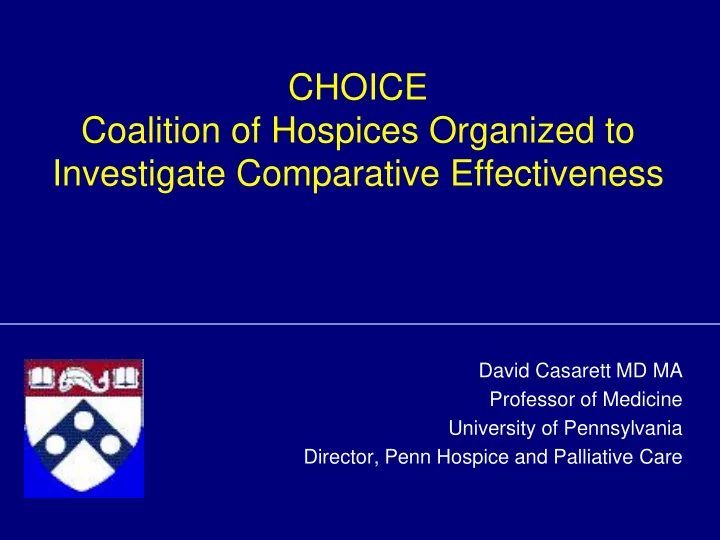

CHOICE Coalition of Hospices Organized to Investigate Comparative Effectiveness David Casarett MD MA Professor of Medicine University of Pennsylvania Director, Penn Hospice and Palliative Care
“ We want a research network that… ” Gives us input into research priorities. Minimizes or eliminates burdens on staff. Avoids intrusive recruitment of patients/families. Offers real time clinical/operations data Tells us how we’re doing (benchmarking)
“That’s just the way we do it”
Outline CHOICE overview and structure Benchmarking » Pain management » Staff visit frequency A learning healthcare system
The CHOICE mission: To define pathways for safe, effective, and efficient hospice care www.choicehospices.org
CHOICE hospices (Phase I) Suncoast Arbor Hospice Hospice of the Faith Presbyterian Bluegrass Hospice Mesilla Valley Hosparus Community Hospice Hospice and of Texas Community Care Agrace Hospice Hospice by the Bay Western Reserve Hospice of Austin
CHOICE dataset N=164,314 5 years of data from 12 hospices Geography: Midwest, Northeast, West, Southeast Size: average daily census range 200-2,000
How CHOICE works: University of Pennsylvania Data analysis (Data with indirect analyzes merged data, identifiers — codes) identified by linking code* Solutions merges FEHC EHR data FEHC data and EHR data and for merge for merge replaces unique identifier with a code. Family Site CHOICE hospices Evaluation Clinical Outcomes/s Quality of contribute FEHC data and data of Hospice urvival indicators EHR data with unique EHR care Care data identifier *Codes remain on hospice server
CHOICE projects so far (selected) Which patients are likely to need inpatient care? Which patients will need the most visits? Does continuous care reduce the likelihood of an inpatient death? Do advance directives change the trajectory of hospice care and site of death? What factors help patients to die in the setting of their choice? Which patients are likely to ‘fail’ the #0209 (comfortable dying) measure? Which patients are likely to die in <1 week?
What we’ve learned We can extract data reliably from Solutions hospices We can develop accurate predictive models that predict important events (inpatient care, visits, site of death, mortality) We can identify and adjust for patient characteristics that influence key outcomes to create meaningful benchmarks » Comfortable dying scores » Visits
Not just benchmarks… … Meaningful benchmarks » Patient-level data » Comparisons among similar populations Two areas: » Operations/cost » Clinical outcomes Aggregate benchmarks (whole hospice/all patients) are easy…and misleading
What my CFO tells me: “At the hospice I used to work for, nurses did 5 visits/day. Ours only do 3.9. We need to be more efficient .” Really? Are we “less efficient” or are we taking care of different patients?
Hospice visit frequency is associated with patient characteristics
Meaningful benchmarks: Visits Hospice A has more visits/day on average than hospice B (1.12 vs. 0.94/day) Hospice B seems to be less efficient But: » Even though Hospice A has more visits, those patients are younger, with lower PPS scores, shorter prognosis, and more likely to have IV opioids at the time of referral. (These patients generally get more visits) Adjusted visits: Hospice A is actually lower than Hospice B (0.99 vs. 1.10)
What my CEO tells me: “At the hospice I consult for, the average comfortable dying score is 85%.* We need to do better .” Really? Do we need to “do better” or are we taking care of different patients? *Proportion of patients with pain that makes them uncomfortable on admission, whose pain is controlled within 48 hours. (National Quality Forum; #0209)
Comfortable dying (#0209) scores are associated with patient characteristics
Meaningful benchmarks: Pain scores (#0209 measure) Hospice A has worse scores on average than hospice B (63% vs. 75%) Actually Hospice A does better at pain management » Even though Hospice A has worse scores, those patients are younger, less likely to have spouse caregivers, and more likely to have cancer » Adjusted scores: Hospice A actually has better than Hospice B (74% vs. 66%)
CHOICE What’s next? Decision Description Benchmarking and support prediction Measurement Improvement Research Goal: Maintain research, add benchmarking
CHOICE phase II Open to all software clients No cost Advantages: » Builds a large benchmarking network » Makes meaningful comparisons possible • By type of hospice • By type of patient
Benchmarking priorities (draft) Hospice information set items Hospice visits (Cost/day) ER visits Revocation rates Use of continuous care at the time of death Delay from referral to admission Evening/weekend calls and emergent visits
How CHOICE benchmarking works University of De-identified and Pennsylvania; compiled Analysis Added value/reports • Benchmarks Data • Trends CHOICE hospices
What hospices will see Reports in EMR User-run (any time) Reports include: » My hospice’s data » Community means, medians, and percentiles » Overall, and for patient subgroups
One example (#0209 measure: Pain control in 48 hours) Your average: 65% Mean (150 hospices): 76% Subgroups (your score vs. mean; # of patients) » Cancer: 66% vs. 64% (n=3,609) » Heart failure: 75% vs. 74% (n=1,132) » Parkinsons: 74% vs. 73% (n=323) Conclusion: » Scores are in line with other hospices » But: High proportion of patients with cancer is decreasing hospice score
CHOICE: A “ learning healthcare system ” “ Background ” Natural data collection variations in care Patient-level data Measure What is changes Sophisticated best? in care analysis Speed/rapid Tools/Traini ng/Triggers turnaround
Identifying best practices “The future is here now. It’s just not very evenly distributed .” -William Gibson
Recommend
More recommend